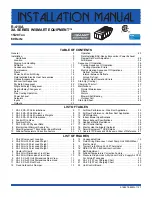
LP-314 Rev. 012 Rel. 003 Date 9.27.19
26
All vent pipes must be glued, properly supported, and the exhaust
pitched a minimum of 1/4” per foot back to the appliance to allow
drainage of condensate. When placing support brackets on vent
piping, the first bracket must be within 1 foot of the appliance
and the balance of 4 foot intervals on the vent pipe. Venting must
be readily accessible for visual inspection from the first three feet
from the appliance.
NOTE:
These drawings are meant to demonstrate system venting
only. The installer is responsible for all equipment and detailing
required by local codes.
2. Venting Through an Existing System
This appliance may be vented through an existing unused vent
system. The inner diameter of the existing vent system is utilized for
the combustion air source. Two methods have been approved for
such venting: Concentric Venting Through an Existing System and
Venting as a Chase.
Vent / Air Inlet Size
Minimum Existing Vent / Chase Size
2”
4”
3”
5”
4”
7”
Table 10 - Minimum Existing Vent / Chase Sizing
NOTES:
A. For every 1” of overhang, the exhaust vent must be located 1” vertical
below overhang (overhang means top of building structure and not
two adjacent walls [corner of building]).
B. Typical installations require 12” minimum separation between
bottom of exhaust outlet and top of air intake.
C. Maintain 12” minimum clearance above highest anticipated snow
level or grade (whichever is greater).
D. Minimum 12” between vents when installing multiple vents.
E. 12” minimum beyond air intake.
Do not install the appliance into a common existing vent with
any other appliance. This will cause flue gas spillage or appliance
malfunction, resulting in substantial property damage, serious
personal injury, or death.
24.00
LP-325-OO
02/04/15
In
take
Exhaust
A
03/31/11
FRONT VIEW
SIDE VIEW
LP-325-PP
EXHAUST
AIR INTAKE
F
E
D
C
EXHAUST
AIR INTAKE
B
Figure 16 - Horizontal (Snorkel) Venting
Figure 17 - Unbalanced Venting - Roof Exhaust and Sidewall Intake
















































